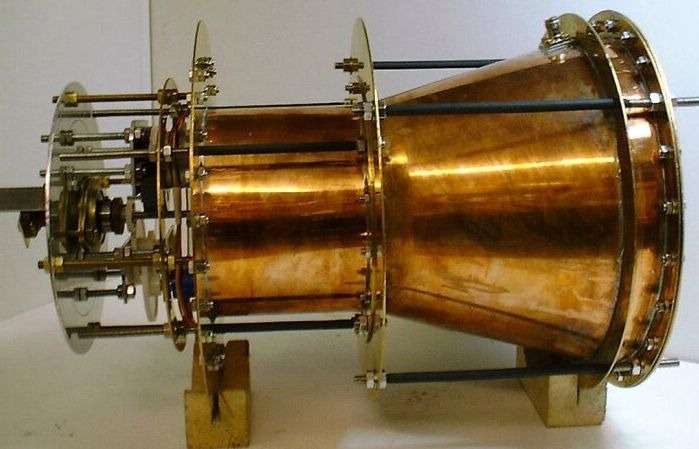Stories about radical new spacedrives pop up surprisingly often. The latest eruption centers around the so-called EMDrive, and it has spread round the world – this link is from a New Zealand website. This gizmo claims to produce forward motion by bouncing microwaves around inside a metal container; warp drives have featured in other, equally far-fetched outbreaks.


Physics-wise, the EMDrive and the Warp Drive are as different as chalk and cheese, even if news reports mix them up. From the look of it, you could cobble together an EMDrive from the guts of a microwave oven in your home workshop, albeit a home workshop with welding and metalworking tools. By contrast, the warp drive springs from a recherché solution to Einstein's general relativity and needs "negative mass" to make it work; no-one has that sort of stuff in their garage.
EMDrives and warp drives do have one thing in common, though: even if you ignore the obvious impossibilities, technical accounts of both devices always seem to be self-contradictory. For the warp drive, there is a huge mismatch between the theory and the experiments that are supposed to test it. For the EMDrive there is indeed data, but the data does not match the predictions of the device's designers. This is normally a cause for concern, but last year's excitement took off before anyone noticed that the EMDrive still "worked" when supposedly crucial parts were removed.
Scientists are naturally skeptical, but the degree to which we are skeptical depends on the circumstances. In the case of the EMDrive we should be very skeptical indeed (as Sean Carroll points out) as it appears to produce momentum out of thin air, something apparently forbidden by the theory used to design it.
That said, an ounce of observation is worth a pound of theory. However, "thin air" is not just a figure of speech here. The effects attributed to the EMDrive are tiny, corresponding to forces far less than the weight of a flea, but large amounts of electrical power must be pumped into the apparatus to produce them. Power generates heat, heat leads to air currents, and these air currents could easily cause enough stray forces to explain the results.
So the next step is to put an EMDrive in a vacuum chamber, and this is what set off the latest round of stories. The work is written up (although the not peer reviewed) and while the EMDrive produces a force in the latest experiments, the force remains when the microwaves are turned off. The EMDrive is supposed to work by bouncing microwaves around inside a fancy tin can, and again the observations do not match the predictions. However, the authors of the latest study prefer to say that it seems the "EMDrive got somehow charged and produced thrust which rather decays contrary to a simple switch off after power is removed [sic]". To me (and any other physicist I could ask) a far simpler explanation is that the device is still not completely isolated from its environment (since magnetic effects show up as well) and again does not work as predicted. But you won't get headlines from that.
Beyond a lack of self-consistency, there is one more common factor between the warp drive and the EMDrive. That is NASA's tiny Eagleworks Laboratory, dedicated to investigating unusual propulsion systems. This is a great idea; we certainly expect NASA to be do cutting edge science. However, this lab has produced credulous analyses of both scenarios, and the kindest thing you can say about this situation is that optimism is winning over rigour. However, if "NASA scientists" weren't involved, the stories would be far less likely to make it into the mainstream media.
Sadly, it seems that the device NASA really needs is a bullshit detector. And if they built one and shared it with the world's journalists we would really have something to celebrate.
CODA: The title image is from Wikimedia – amazing what you can find if you look. And this blog by Corey Powell gives a lot of background information on the previous claims about the EMDrive.
